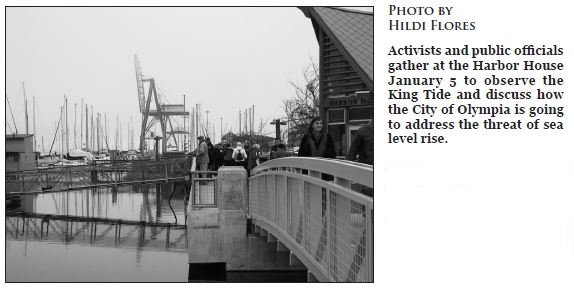King Tide Reminds Downtown Olympia of its VulnerabilityBy Hildi Flores
"[The tides] are going to keep increasing and downtown Olympia is going to be flooded eventually," said Bourtai Hargrove, a member of the Fellowship of Reconciliation, "We hope to hear from the people of the City of Olympia about what their plans are. Are they going to be building a huge seawall to protect us from these tides? Or are they going to be moving downtown Olympia? Those are two choices." Andy Haub, Planning and Engineering Manager for the City of Olympia, addressed the group's concerns and said the city has been looking at the issue of sea level rise since 1990, but it wasn't until 2007 that the city started taking more action. "With regard to sea rise, we've done a lot of work in the past five years," said Haub. "We spent a couple years studying how Budd Inlet responds to flooding and how it could respond to sea rise. We've also looked at our built environment, all the pipes underneath the streets. At this point we have both a good understanding of Budd Inlet and our downtown environment. What we don't understand is sea rise: how much and how soon." It was noted the effect of this tide was not as dramatic as the high tide observed in December 2012, which flooded the Oysterhouse parking lot and part of Sylvester St. (See Summer 2013 edition of South Sound Green Pages) This difference in effect is attributed to barometric pressure: when air pressure is high, it keeps the water in the ocean, but when air pressure is low, more water flows into the Puget Sound. The combination of low air pressure and an exceptionally high tide led to flooding last December, while this season's King Tide was suppressed by high air pressure. One concern is the combination of a high tide, low air pressure, and a storm surge, which could lead to serious damage of public and private facilities lining Olympia's waterfront. Regardless of the possibility of this worst case scenario, activists reminded public officials the sea level will continue to rise due to climate change and insist bold actions be taken. However, taking effective action is dependent upon coordination of multiple jurisdictions. "I think our challenge is what one single jurisdiction can do on this issue," said Olympia Mayor Stephen Buxbaum. "We have a lot of overlapping jurisdictions that are responsible for this shoreline." One entity with jurisdiction over a large portion of the shoreline is the Port of Olympia, with its marina, marine terminal, and rental properties on the peninsula. "We have development choices," said Sue Gunn, the newly elected Port Commissioner. "We can either enhance or diminish the problem. Particularly with the Port ,there are a lot of development choices. Being the new person and getting the tour of the Cascade Pole facility and learning that it has to exist 200-300 years because of the pollution, it becomes obvious that some things are going to have to be protected in order to protect the population." Many insist the flooding of downtown is inevitable, considering most of the area was part of the Deschutes river estuary before the city was built upon the dredge fill of prior industrial operations in Budd Inlet. "One of my concerns is that things are happening faster than any of the computer programs have predicted," said Rod Tharp. "It's going to create a lot of infrastructure problems in the area, so I'd like to see the city be working more aggressively. This area was flooded 100 years ago and will be flooded again within the next hundred years, but probably in a lot shorter time than that." Some saw the Shoreline Master Program (SMP) as an opportunity to address sea level rise, but the process resulted in minimal setbacks. In an interview with the Green Pages, Buxbaum said he doesn't think the SMP is the primary regulatory tool to address sea level rise. "The Shoreline Management Act (SMA) was written in 1982 and doesn't taken into consideration sea level rise. We either need to make major changes to the SMA or we need a new approach." After the gathering, some activists stayed to discuss how to keep the pressure on city officials. Activist Patricia Holm noted a sea wall would be needed to protect public investments such as LOTT and the Port of Olympia. "The city is grappling," she said. "They don't know which way to turn and need somebody to step up." Glen Anderson reminded the group not to let the King Tide have them think of the climate crisis as an "annual episode." "Gathering annually for a few hours to share information is not enough," said Anderson. "We need to organize urgently and continuously to demand very immediate and very bold actions from all levels of government and from other sectors of society to counteract the damage that the climate crisis is increasingly causing." Hildi Flores is Managing Editor of the South Sound Green Pages and a graduate of The Evergreen State College.
Back to Home page. |

 On the morning of January 5 the Fellowship of Reconciliation, Climate Crisis Group, and Olympia Movement for Justice hosted a gathering at the Harbor House to observe the King Tide, one of the highest tides of the year. City officials were invited to discuss with the public their efforts to mitigate the threat of sea level rise to downtown facilities.
On the morning of January 5 the Fellowship of Reconciliation, Climate Crisis Group, and Olympia Movement for Justice hosted a gathering at the Harbor House to observe the King Tide, one of the highest tides of the year. City officials were invited to discuss with the public their efforts to mitigate the threat of sea level rise to downtown facilities.